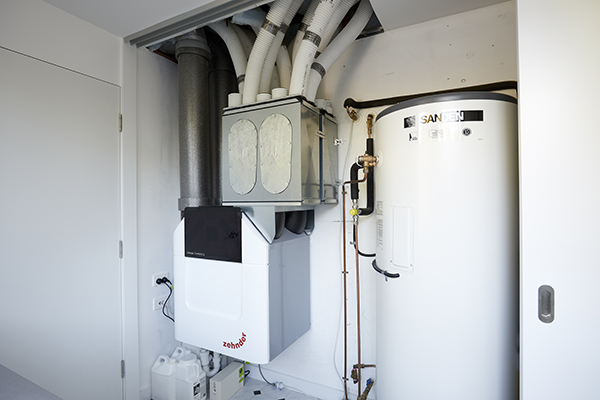How HRV Ensures a Healthier Indoor Living Environment
Wiki Article
The All-Inclusive Overview to the Uses of Heat Recovery Ventilation in Modern Structures
Heat Recovery Ventilation (HRV) systems stand for a significant improvement in constructing technology (HRV Heat Recovery Ventilation). They give an approach for trading stale indoor air with fresh outdoor air while decreasing energy loss. This strategy not only enhances indoor air quality however also contributes to power effectiveness in both domestic and business structures. Understanding the numerous applications and benefits of HRV can expose its critical role in contemporary style and sustainability efforts. The implications of this technology are worth checking out betterRecognizing Heat Recovery Ventilation Systems

Although many contemporary buildings focus on power effectiveness, understanding warmth recovery ventilation (HRV) systems is crucial for enhancing indoor air top quality and reducing power usage. HRV systems function by transferring warmth from stagnant indoor air to incoming fresh air, properly preserving comfortable interior temperature levels while minimizing energy loss. These systems consist of a heat exchanger, followers, and ductwork that assist in the circulation of air. During winter season, HRV systems capture and reuse heat from the outgoing air, while in summer season, they can assist cool incoming air. By continuously exchanging air, HRV systems also decrease moisture and the focus of interior contaminants. Appropriate installation and maintenance of HRV systems are essential for their efficiency and effectiveness in improving general structure efficiency and convenience.
Benefits of Heat Recovery Ventilation
Heat recovery ventilation systems supply various advantages that improve both power effectiveness and interior air top quality in contemporary buildings. By capturing and reusing energy from exhaust air, these systems considerably reduce heating & cooling costs, causing lower power usage. Moreover, they preserve a steady circulation of fresh outside air, decreasing the threat of indoor air toxins and allergens. This continual exchange assists manage moisture degrees, protecting against mold development and making sure a much healthier living environment. Additionally, HRV systems add to sustainability goals by decreasing general carbon impacts. Their capacity to optimize ventilation without compromising thermal comfort makes them a useful enhancement to modern building style, promoting both financial and eco-friendly advantages.Applications of HRV in Residential Buildings
As homeowners significantly focus on power effectiveness and indoor air quality, the applications of warm healing ventilation (HRV) systems in property structures have actually come to be much more prevalent. HRV systems are particularly useful in snugly secured homes, where keeping fresh air circulation is vital for preventing HRV Heat Recovery Ventilation dampness buildup and indoor pollutants. They successfully move heat from outgoing stagnant air to incoming fresh air, reducing energy costs connected with heating & cooling. Additionally, HRVs can boost convenience degrees by regulating humidity and temperature. They are also versatile for various domestic layouts, consisting of single-family homes and multi-unit buildings. Generally, integrating HRV systems sustains lasting living techniques while guaranteeing a healthier indoor atmosphere for occupants.HRV in Commercial and Industrial Setups
In business and commercial settings, the application of warm recovery ventilation (HRV) systems has come to be significantly essential for optimizing power efficiency and maintaining air top quality. These systems effectively move warmth from exhaust air to inbound fresh air, minimizing the need for extra heating or air conditioning. This not just decreases energy costs however also adds to sustainability efforts. Industries such as production, warehousing, and workplace buildings profit substantially from HRV systems, as they aid manage temperature and moisture levels, ensuring a comfortable and efficient atmosphere. HRV systems aid in removing contaminants and excess wetness, enhancing indoor air quality. As regulations around air top quality become stricter, the adoption of HRV technology is most likely to expand, making it a critical element of contemporary business and industrial facilities.Future Fads in Heat Recovery Ventilation Innovation

Frequently Asked Inquiries
How Does Heat Recovery Ventilation Effect Indoor Air Quality?
Heat recovery ventilation significantly enhances interior air high quality by constantly trading stagnant indoor air with fresh outside air while recuperating power. This process minimizes pollutants, preserves excellent humidity degrees, and guarantees a healthier atmosphere for occupants.Can HRV Solutions Be Mounted in Existing Buildings?
HRV systems can indeed be set up in existing structures. Retrofitting may require alterations to ductwork and air flow formats, however it considerably enhances power efficiency and indoor air high quality, making it a feasible choice for older frameworks.What Maintenance Is Required for HRV Systems?

Are There Particular Climates Where HRV Is Much More Reliable?
Heat recovery ventilation systems are particularly reliable in environments with substantial temperature differences in between periods. These systems enhance energy efficiency by recouping warmth from exhaust air, making them ideal for both cool and reasonably cozy atmospheres.Just How Do HRV Systems Affect Energy Bills?

Report this wiki page